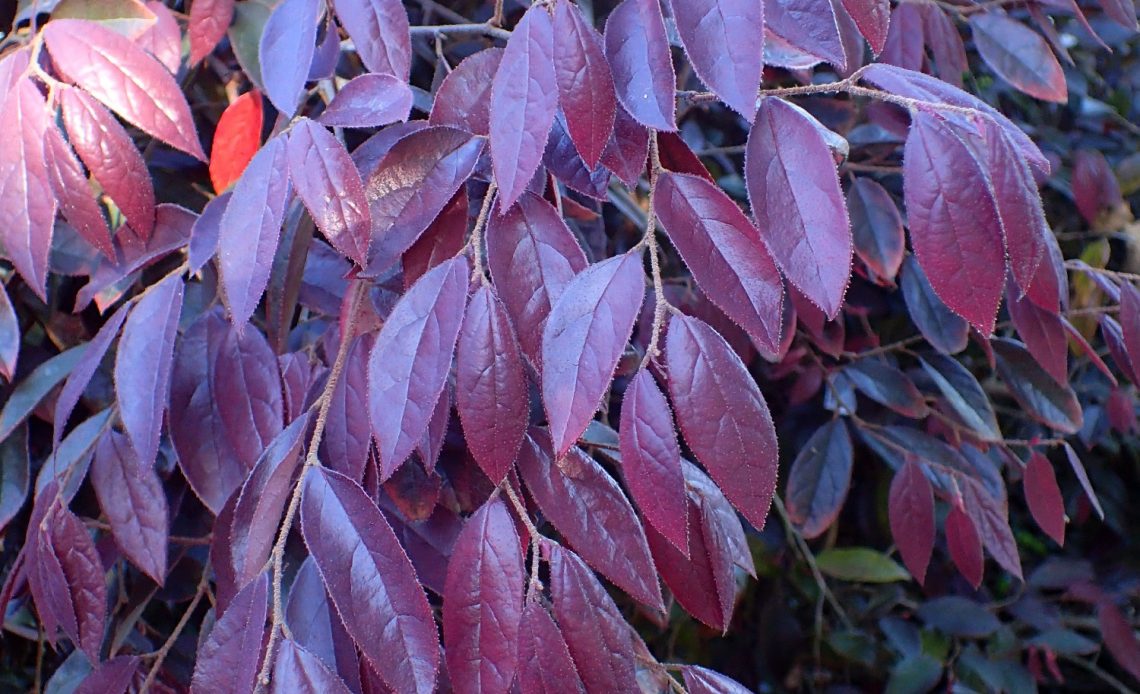

We’re here to help! Wild Yards is a completely free website that is 100% dedicated to helping you create a wildlife-friendly, sustainable yard. Read more
WildYards is reader-supported. When you buy a product through a link on our site, we may earn a comission. Every product is independently selected by our (obsessive) editors and our reviews are unbiased and objective. Read more about our mission or our privacy policy.
The cold winter temperatures can turn your once glorious landscaping into a desolate wasteland. That’s why it’s so important to include evergreens as part of your garden — to keep a dash of greenery in your yard throughout the dreary gray months. But evergreens come in more colors than just green. Many evergreens produce foliage in shades of red, and there are several purple evergreen shrubs that can jazz up your landscaping, too.
‘Royal Purple’ Smoke Bush can be grown as a bush or trimmed to look like a small tree, while the ‘Ruby’ and ‘Carolina Midnight’ varieties of Loropetalum can be grown as a hedge. And ‘Purple Daydream’ Dwarf Loropetalum’s small stature makes it a perfect choice for small backyards and patio container gardens.
10 Best Purple Evergreen Shrubs for Your Garden
Unlike deciduous shrubs, including hydrangeas and azaleas, evergreens maintain their foliage all year long — in part because their leaves are incredibly cold tolerant. So even when the other plants in your landscaping are nothing but twigs during the cold months, your evergreens will press on, undaunted. If you want to add a bit more color to your winter garden, these 10 purple evergreen shrubs are a great place to start!
‘Royal Purple’ Smoke Bush (zones 5 through 9)
You want a beautiful yard, but you don’t have the time to pamper your plants. Fortunately, the ‘Royal Purple’ Smoke Bush couldn’t be easier to care for. This large shrub (or small tree, depending on how you trim it) adapts to many different types of soil, and when it’s planted in full to partial sunlight, it can reach its maximum size of 15 feet tall by 15 feet wide.
‘Royal Purple’ Smoke Bush produces deep mahogany, purple foliage, and sprays of smoke-like purple and white flowers, a mesmerizing contrast from the plant’s oval leaves. This shrub should be watered regularly when first planted. Keeping the soil moist, but not sopping wet, helps the roots develop. Once established, ‘Royal Purple’ Smoke Bush is exceptionally drought-tolerant, making this gorgeous purple evergreen a worthy addition to your garden.
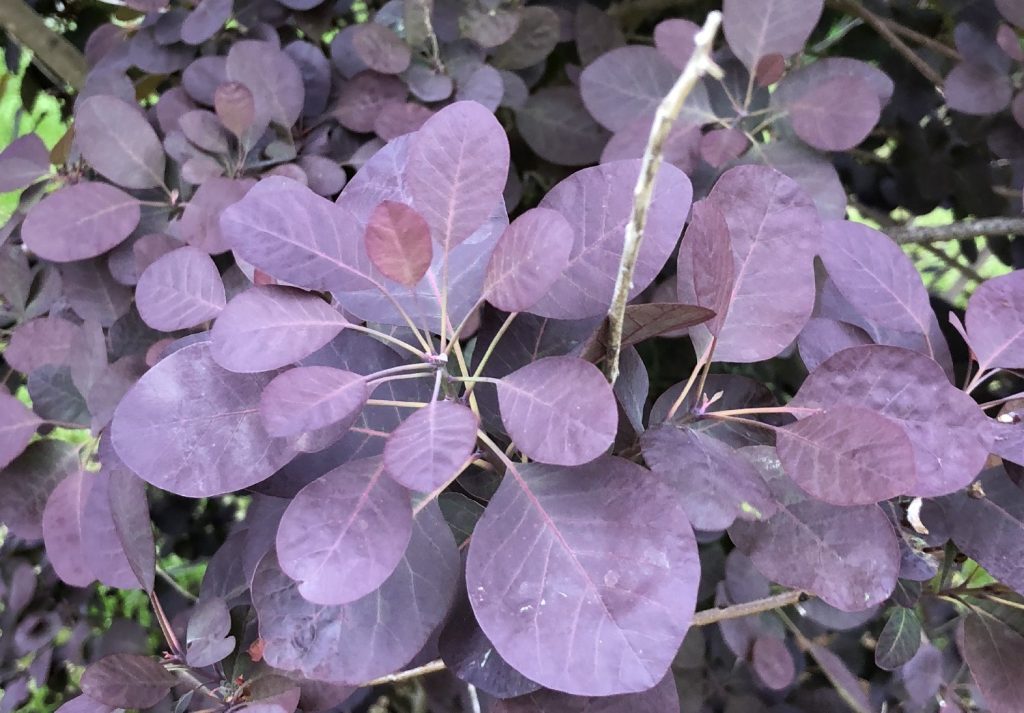
‘Purple Pixie’ Dwarf Weeping Loropetalum (zones 7 through 9)
Loropetalums are some of the most popular purple evergreen shrubs around, and the ‘Purple Pixie’ Dwarf Weeping variety is by far one of the prettiest. This Loropetalum’s magnificent purple to red foliage cascades over and around the plant, making it perfect for growing in window boxes and hanging baskets. If you have a retaining wall in your garden, ‘Purple Pixie’ Dwarf Weeping Loropetalum makes the perfect border.
This plant grows best in full to partial sun, where it grows about 2 feet tall by 5 feet wide. The plant’s flashy pink blooms appear in spring, and they’re popular with insects and birds. Grow your ‘Purple Pixie’ Dwarf Weeping Loropetalums in any soil, as long as it drains well, and be sure to water it whenever the soil dries out about 2 inches down.
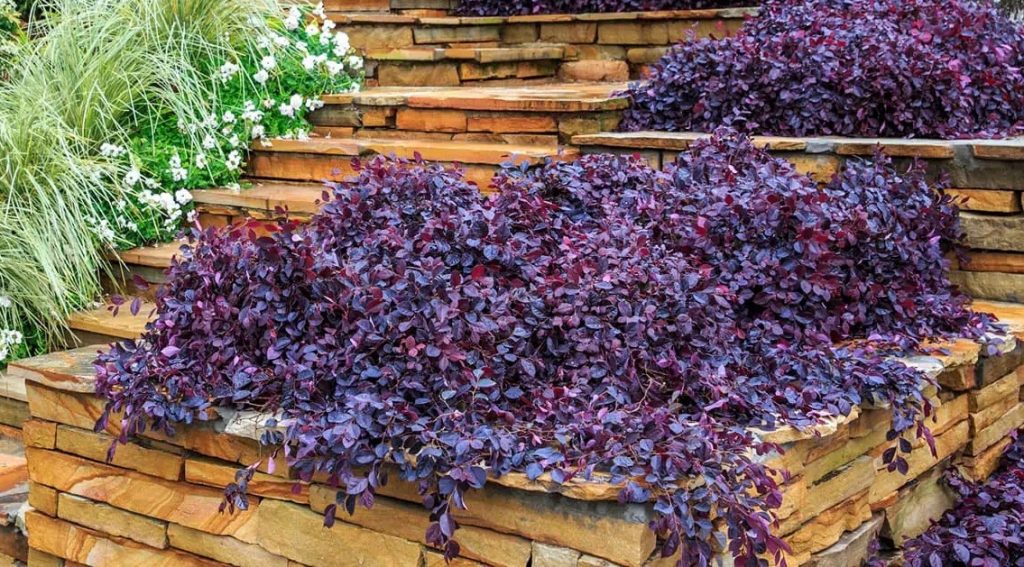
‘Lilla’ Smoke Bush (zones 4 through 8)
If you’re in love with the look of the ‘Royal Purple’ Smoke Bush, but your yard just doesn’t have the space for one, choose ‘Lilla’ Smoke Bush instead. Lilla is the dwarf variety of the ‘Royal Purple’ Smoke Bush, growing only about 4 feet tall by 4 feet wide. This shrub’s uniform shape means it can be planted alone as an accent shrub for your flower beds. ‘Lilla’ Smoke Bush grows best in full to partial sunlight and should be watered regularly, especially during droughts.
The ‘Lilla’ Smoke Bush produces dozens of bright pink flowers in the summer. And, as summer turns into fall, this shrub’s wine-colored leaves fade to orange and coral red. It should be noted that ‘Lilla’ Smoke Bush is only evergreen in warm climates. In cooler regions, this plant grows deciduously. Growing this plant near your house where it can stay protected from freezing temperatures can help it retain its foliage year-long.
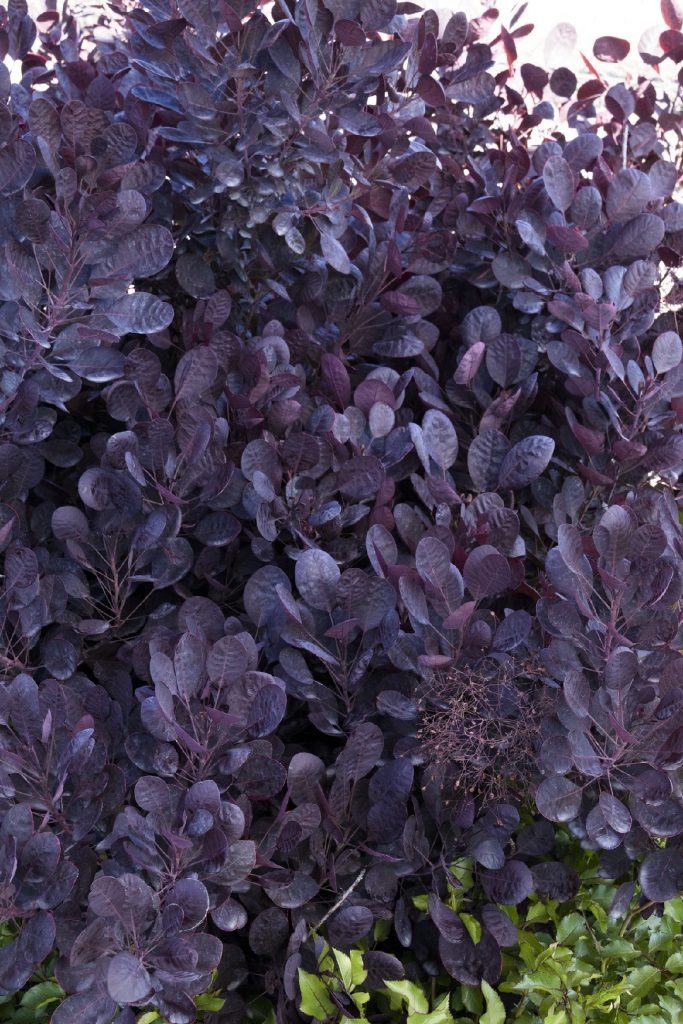
‘Ruby’ Loropetalum (zones 7 through 9)
Once you’ve seen a ‘Ruby’ Loropetalum in person, it’s hard to forget it. This versatile ornamental shrub produces brilliant fuchsia leaves and bright pink blossoms. At 6 feet tall by 6 feet wide, this statement shrub is a feast for the eyes and looks just as gorgeous planted on its own as it does when planted as a hedgerow.
‘Ruby’ Loropetalum’s new growth is a vibrant ruby red (no surprise there!), with leaves turning purple and then burgundy as the season progresses. This plant is well-suited to container gardening, as it can be trimmed back to maintain a small size. Grow your ‘Ruby’ Loropetalum in acidic, well-drained soil, and be sure to keep the soil moist. Spreading a layer of mulch evenly at the base of the plant will help keep it hydrated.
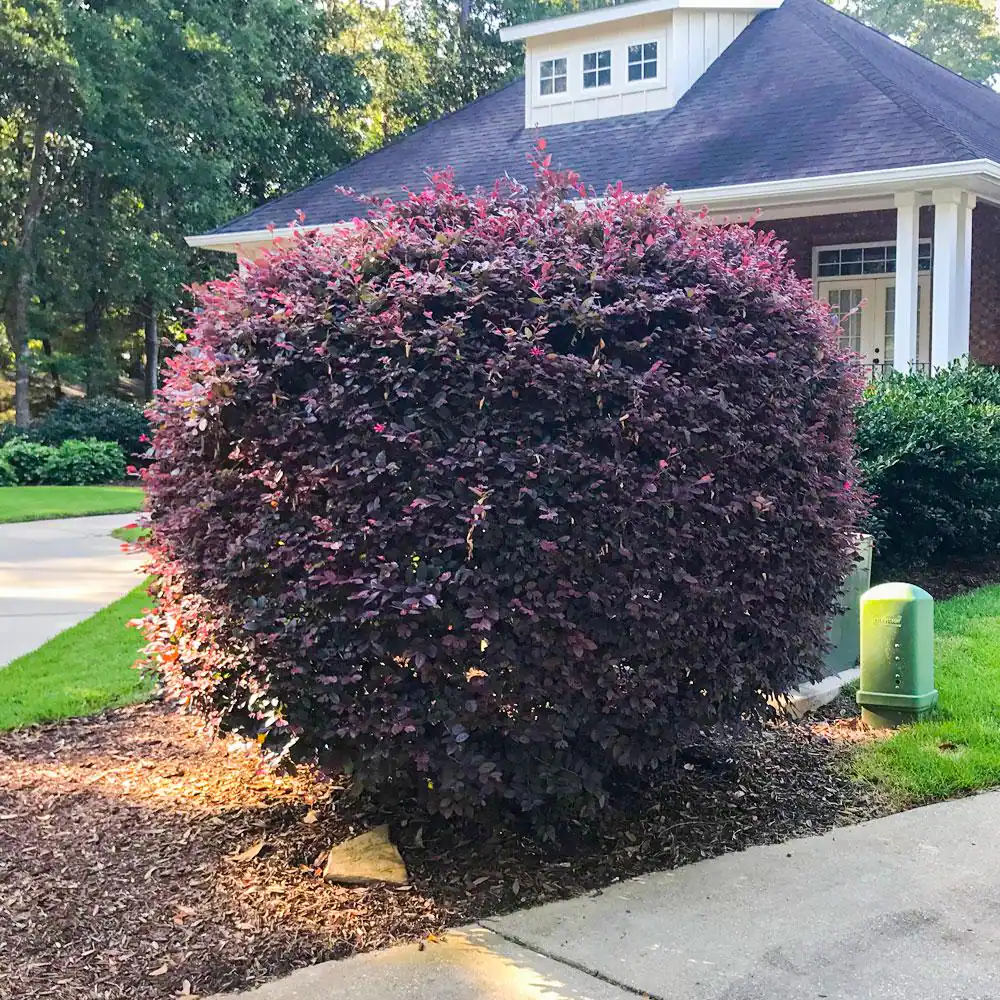
‘Razzleberri’ Fringe Flower (zones 7 through 9)
An exciting addition to any landscape, ‘Razzleberri’ Fringe Flower’s new foliage emerges in shades of deep amethyst and burgundy. As the oval-shaped leaves mature, the purple gives way to bright olive green. The ‘Razzleberri’ Fringe Flower plant produces dozens of bright pink flowers throughout the year. At 6 feet tall and 5 feet wide, this is an excellent purple evergreen shrub to use as an accent to your flower beds.
Like ‘Ruby’ Loropetalum, ‘Razzleberri’ Fringe Flower can be grown in pots. These plants should be grown in well-drained soil that is kept moist. Again, mulch can be helpful in preventing water loss. ‘Razzleberri’ Fringe Flower prefers full to partial sunlight and can be given a slow-release tree/shrub food to enhance foliage and bloom production.
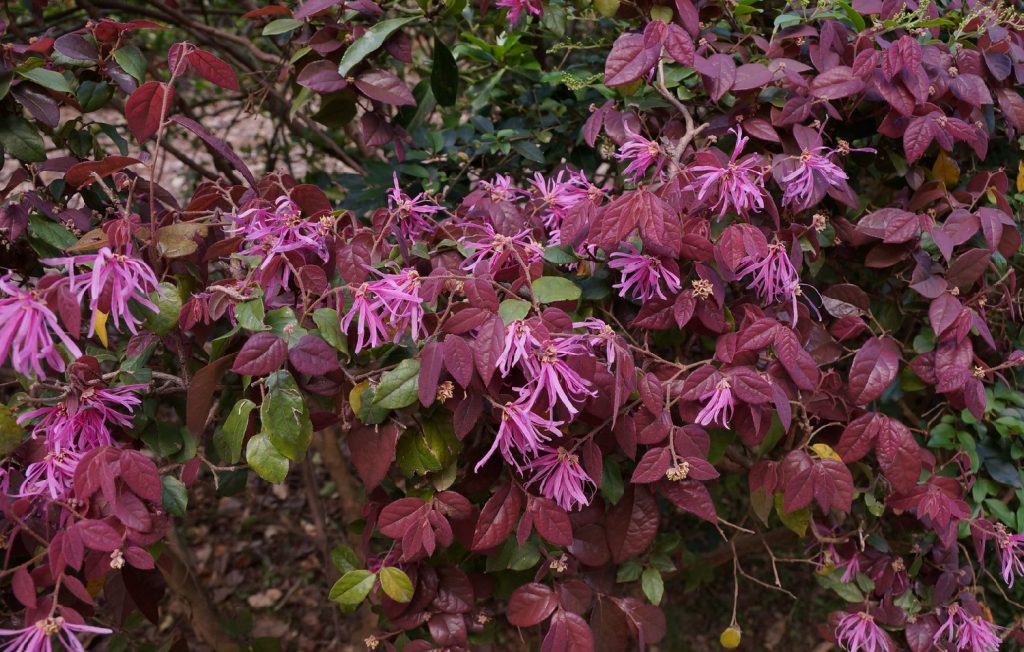
‘Carolina Midnight’ Loropetalum (zones 7 through 10)
If you live in a region with a large deer population, planning your landscaping is no easy task. You’ve got to choose plants that are deer-resistant to keep those hungry critters at bay. Fortunately, keeping the deer disinterested is easy with ‘Carolina Midnight’ Loropetalum. Deer hate the way this beautiful hedging plant tastes, with its glossy purple leaves, and fragrant fuchsia blooms.
Untrimmed, ‘Carolina Midnight’ Loropetalum grows 15 feet tall by 10 feet wide. These plants should be grown in partial shade in acidic, well-drained soil that’s moderately nutrient-dense. If you have sandy soil, be sure to amend it with a few cups of compost. The ‘Carolina Midnight’ Loropetalum will benefit from the minerals in the organic matter, plus it helps keep the soil loose enough for the roots to grow uninhibited.
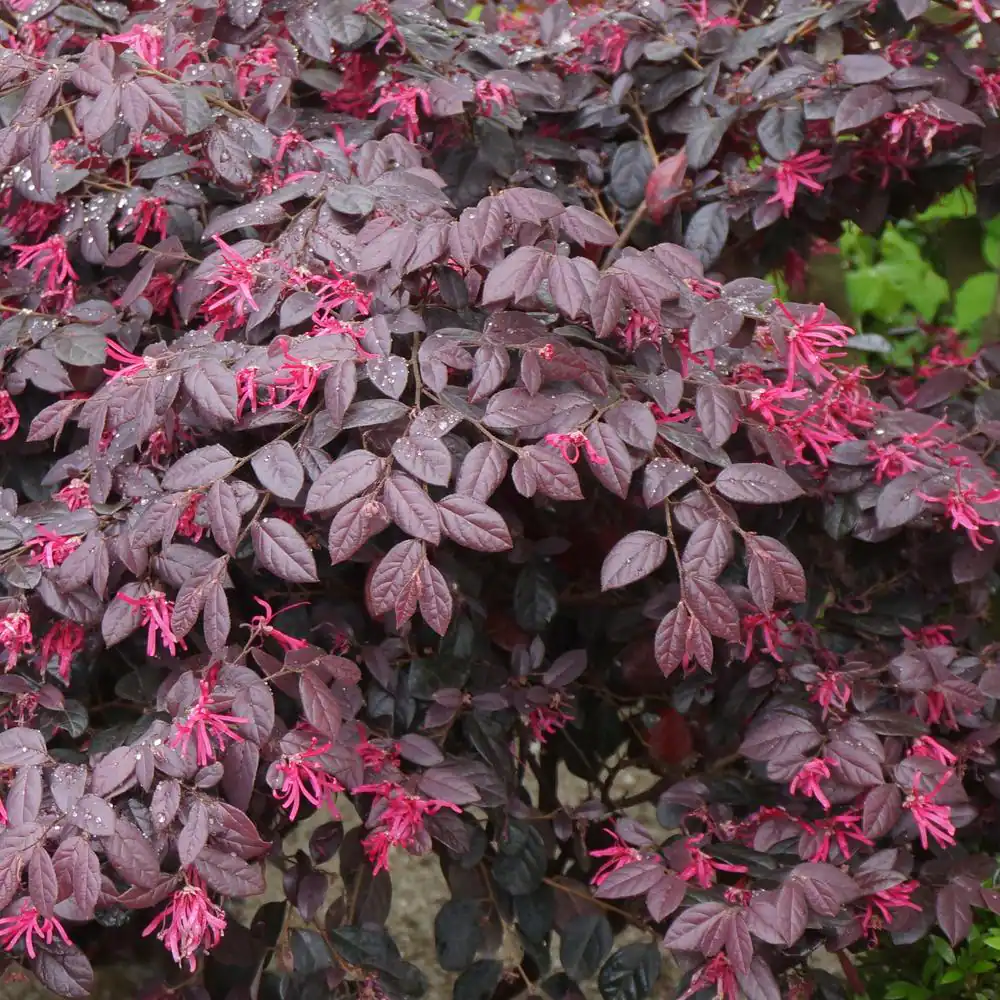
‘Purple Majesty’ Fringe Flower (zones 7 through 10)
A medium-sized shrub that grows at a moderate pace, the ‘Purple Majesty’ Fringe Flower has a round silhouette that looks great on its own but can be trimmed for a more manicured appearance. This purple evergreen shrub grows best when it can receive morning sun and afternoon shade. Plant your ‘Purple Majesty’ Fringe Flower bushes in well-drained soil and water them biweekly for best results.
This plant produces deep purple to dark red foliage year-round. In the spring, hot pink fringed flowers make their debut, attracting beetles, bees, and other pollinating insects to your garden. This particular purple evergreen shrub’s dramatic coloring makes it a bold focal point for your garden, whether you grow it in your flower beds or pots on your back patio.
‘Purple Diamond’ Semi-Dwarf Loropetalum (zones 7 through 10)
When planted in clusters, ‘Purple Diamond’ Semi-Dwarf Loropetalums create a dense hedge, perfect for flower beds and multi-level backyards. These plants max out at 6 feet tall by 5 feet wide, and when planted in close proximity, they can quickly fill in your landscaping with a brilliant display of purple foliage. In the spring, their bright pink flowers attract butterflies and other pollinators to your backyard.
‘Purple Diamond’ Semi-Dwarf Loropetalum grows best in full to partial sunlight when planted in well-drained soil. Be sure to water these plants regularly, especially during dry spells. Planting ‘Purple Diamond’ Semi-Dwarf Loropetalums in with other ornamental plants is a good strategy because it helps shade the ground around the roots from the sun’s rays, locking moisture in to keep the whole flower bed hydrated.
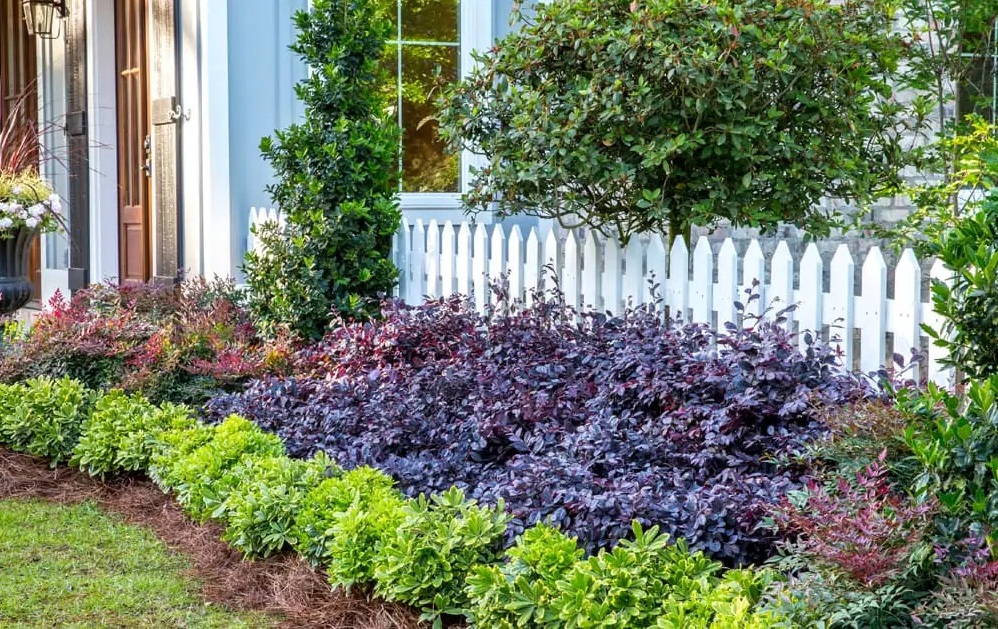
Purple Daydream Dwarf Loropetalum (zones 7 through 10)
Growing 3 feet tall by 4 feet wide, ‘Purple Daydream’ Dwarf Loropetalum is so small it’s perfect for container gardens, but it makes an excellent border between flower beds and walking paths, too. ‘Purple Daydream’ Dwarf Loropetalum is a broadleaf shrub, with oval leaves in varying shades of amethyst and burgundy. This plant has a moderate growth rate and a compact, mounding growth pattern making it well-suited to flower beds.
This particular purple evergreen shrub is deer-resistant, pest-resistant, and disease-resistant, making it incredibly low-maintenance. Simply plant your ‘Purple Daydream’ Dwarf Loropetalums in full to partial sunlight and well-drained soil. In the spring, this plant will steal the show with its pretty pink flowers. And when the blooms fade and the cold weather comes, your ‘Purple Daydream’ Dwarf Loropetalums will keep your flower beds looking great, even when your other ornamentals have gone dormant.
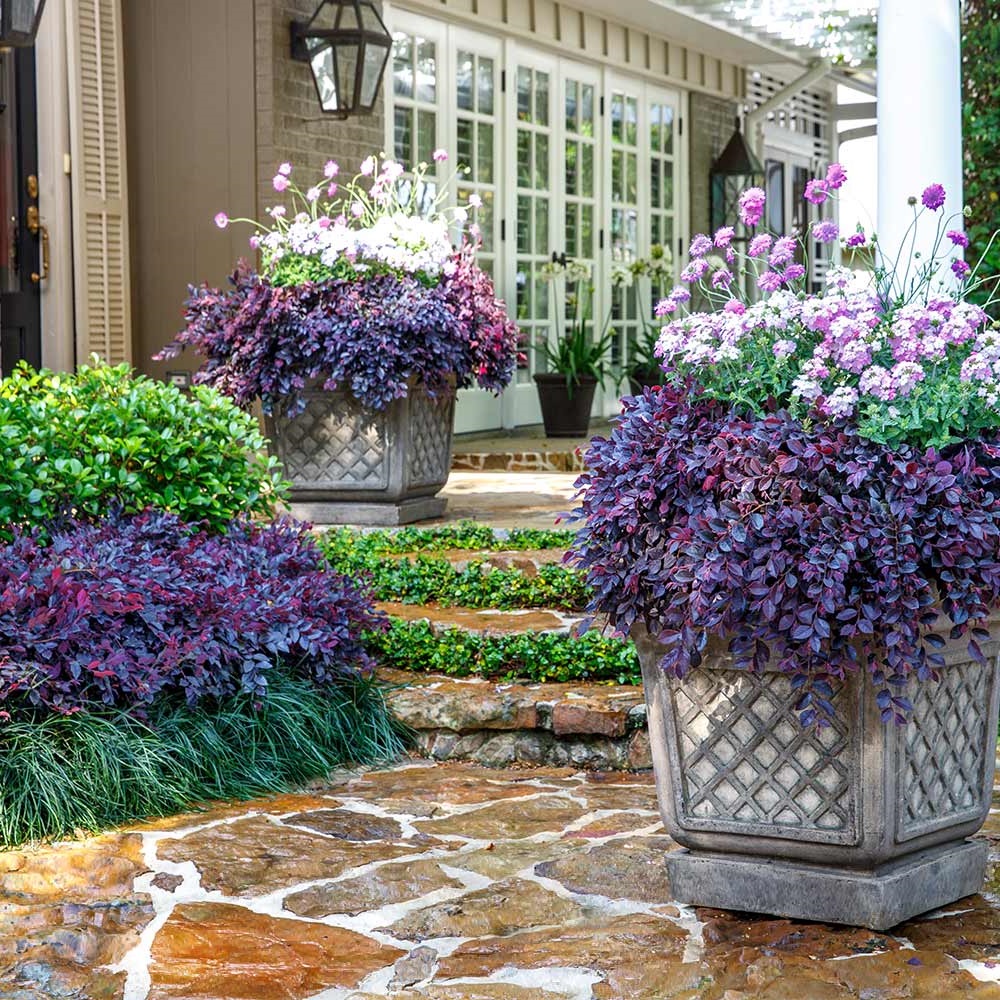
Caring for your purple evergreen shrubs
Unfortunately, there aren’t very many purple evergreen shrubs. They’re mostly restricted to Loropetalums. But with so many different varieties to choose from, there’s a Loropetalum to suit every garden. No matter which purple evergreen shrub you choose, be sure to meet the plant’s growing requirements. This is the best way to ensure the plant starts healthy and stays healthy.
Purple evergreen shrubs prevent your landscaping from becoming one-dimensional by providing it with a splash of color. Whether you grow them in pots or as borders for your flower beds, these purple plants will be a fabulous addition to your backyard.
